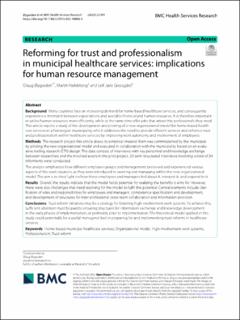| dc.contributor.author | Øygarden, Olaug | |
| dc.contributor.author | Nøkleberg, Martin | |
| dc.contributor.author | Gressgård, Leif Jarle | |
| dc.date.accessioned | 2023-11-10T13:11:23Z | |
| dc.date.available | 2023-11-10T13:11:23Z | |
| dc.date.created | 2023-10-05T09:03:33Z | |
| dc.date.issued | 2023 | |
| dc.identifier.citation | BMC Health Services Research. 2023, 23 (1), . | en_US |
| dc.identifier.issn | 1472-6963 | |
| dc.identifier.uri | https://hdl.handle.net/11250/3101931 | |
| dc.description.abstract | Background Many countries face an increasing demand for home-based healthcare services, and consequently experience a mismatch between expectations and available financial and human resources. It is therefore important to utilize human resources more efficiently, while at the same time offer jobs that attract the professionals they need. This article reports a study of the development and piloting of a new organizational model for home-based healthcare services in a Norwegian municipality, which addresses the need to provide efficient services and enhance trust and professionalism within healthcare services by improving work autonomy and involvement of employees. Methods The research project this article draws its empirical material from was commissioned by the municipality piloting the new organizational model and executed in collaboration with the municipality based on an evaluative trailing research (ETR) design. The data consists of interviews with key personnel and knowledge exchange between researchers and the involved actors in the pilot project. 20 semi-structured interviews involving a total of 34 informants were conducted. The analysis emphasises how different employee groups and management perceived and experienced various aspects of the work situation, as they were introduced to working and managing within the new organizational model. The aim is to shed light on how these employees and managers feel about it, interpret it, and respond to it. Results Overall, the results indicate that the model holds potential for realizing the benefits it aims for. However, there were also challenges that need resolving for the model to fulfil this potential. Central elements include clarification of roles and responsibilities for employees and managers, competence specification and development, and development of structures for inter-professional cross-team collaboration and information provision. Conclusions Trust reform initiatives may be a strategy for fostering high-involvement work systems. To achieve this, sufficient attention must be paid to ensuring structures for information exchange and knowledge development in the early phases of implementation, or preferably prior to implementation. The theoretical model applied in this study could potentially be a useful managerial tool in preparing for and implementing trust reforms in healthcare services. | en_US |
| dc.language.iso | eng | en_US |
| dc.publisher | BioMed Central | en_US |
| dc.rights | Navngivelse 4.0 Internasjonal | * |
| dc.rights.uri | http://creativecommons.org/licenses/by/4.0/deed.no | * |
| dc.title | Reforming for trust and professionalism in municipal healthcare services: implications for human resource management | en_US |
| dc.type | Peer reviewed | en_US |
| dc.type | Journal article | en_US |
| dc.description.version | publishedVersion | en_US |
| dc.rights.holder | © The Author(s) 2023 | en_US |
| dc.source.pagenumber | 131 | en_US |
| dc.source.volume | 23 | en_US |
| dc.source.journal | BMC Health Services Research | en_US |
| dc.source.issue | 1 | en_US |
| dc.identifier.doi | 10.1186/s12913-023-10006-8 | |
| dc.identifier.cristin | 2181874 | |
| dc.source.articlenumber | 991 | en_US |
| cristin.ispublished | true | |
| cristin.fulltext | original | |
| cristin.qualitycode | 2 | |

